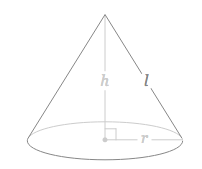A pile of dirt or sand is roughly an upside down cone in many instances.
To figure out the weight (mass) we multiply the volume in litres by the SG (specific gravity) of sand.
Ordered Steps
7. RULE: To find the mass. Find the SG from this table and multiply by the litres.
6. About Specific Gravity (SG)
5. The number π (pronounced pie) (spelt pi)
4. Algebra – Variables – substituting numbers for letters.
3. Math 2
2. Basic math.
1. English.
A cone.

The formula for a cone is
As you can see, Google has a nice little pre made calculator for you.
Where:
V= volume
π = 3.14 = pronounced “pi”
r = radius
h = height
This video from PatrickJMT steps you through the calculation method.
For our example of a pile of sand, we will say it has these dimensions:
r = radius = 1.3m
h = height = 0.8m
Or if you cut and paste the following into Google search
pi()*(1.3^2)*0.8/3
it will give you the answer 1.43 m^3 (pronounced as cubic metres)
Instead of cm use m (metres) to end up with m^3.
Litres in a cubic metre = 1000
Volume_of_cone_m^3 * litres_per_cubic_metre = Volume_of_cone_Litres
1.43 * 1000 = Volume_of_cone_Litres
1430L = Volume_of_cone_Litres
SG (Specific Gravity) table
SG of sand = 2.6kg/Litre
SG_sand * Volume_of_cone_Litres = Sand_mass
2.6 * 1430 = Sand_mass
3718kg = Sand_mass
Sand_mass = 3718kg